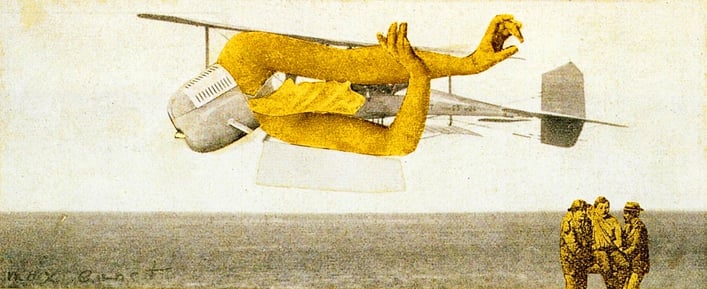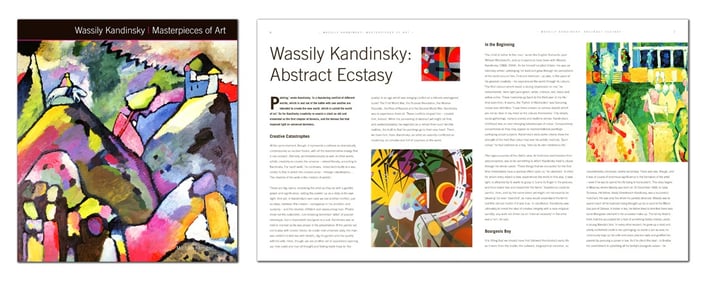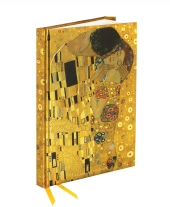 Wassily Kandinsky is considered to be the 'Father of the Abstract.' From an early age he had a strong connection to colour and throughout his artistic career he was interested in the portrayal of colours and shape. It took a simple mix up, when his wife accidentally set his work in progress on its side, for him to find artistic truth. Kandinsky's art was an extension of his spiritual thoughts and the abstract works that he created inspired many artists and art movements.
Wassily Kandinsky is considered to be the 'Father of the Abstract.' From an early age he had a strong connection to colour and throughout his artistic career he was interested in the portrayal of colours and shape. It took a simple mix up, when his wife accidentally set his work in progress on its side, for him to find artistic truth. Kandinsky's art was an extension of his spiritual thoughts and the abstract works that he created inspired many artists and art movements.
Abstraction is the separation of the object and the art. It is a search for the true essence of the subject. Kandinsky's work with abstraction and his intellectual musings led to some extreme art forms. One such movement is the Dada movement, but perhaps it is best to call Dadaism a non-movement. Tristan Tzara, one of the central figures of Dadaism said: "I am against systems, the most acceptable system is on principle to have none."
Dadaism is an anti-art movement that came to the art scene in 1916 as a response to the violence and trauma of the First World War. With a nod to Kandinsky and his abstraction, the Dada movement began in Zurich, in neutral Switzerland. A cafe opened called the Cabaret Voltaire where free-thinking artists and intellectuals gathered with their Dada ideas. Richard Huelsenbeck noted that 'abstract art signified absolute honesty for us.' Abstract art was considered an instinctual expression of inner consciousness.

'Dada applies itself to everything, and yet it is nothing.' - Tristan Tzara
But Dada was not simply an artistic protest in Zurich. Anti-art was created in several other European cities as well as New York. Dadaists challenged the idea of art and turned away from its values. Dada artists wanted to oppose traditional art and so they created anti-art. They created pieces without the tools of the artist: without paintbrushes or even paint. They pieced together anti-art with scraps of paper, ticket stubs, and even rubbish found on the street. Much of their works were violent and aggressive as a response to the violence of the war.
Tristan Tzara wrote controversial manifestos declaring 'The acts of life have no beginning or end. Everything happens in a completely idiotic way. That is why everything is alike. Simplicity is called Dada.'
'Nothing is more delightful than to confuse and upset people.' -Tristan Tzara
 By stitching together photographs printed in newspapers and found objects into photomontages and collages, Dadaism challenged the boundaries between high and low art. Artists created whimsical pieces with serious intent. One artist, or anti-artist, Marcel Duchamp, painted a moustache and beard on a copy of the Mona Lisa with the caption 'L.H.O.O.Q.' In French, the letters read as 'Elle a chaud au cul' which is a vulgar phrase, and when read in English the letters form the word 'look.' It is precisely this kind of modification to a previous artwork that serves to shock and offend viewers.
By stitching together photographs printed in newspapers and found objects into photomontages and collages, Dadaism challenged the boundaries between high and low art. Artists created whimsical pieces with serious intent. One artist, or anti-artist, Marcel Duchamp, painted a moustache and beard on a copy of the Mona Lisa with the caption 'L.H.O.O.Q.' In French, the letters read as 'Elle a chaud au cul' which is a vulgar phrase, and when read in English the letters form the word 'look.' It is precisely this kind of modification to a previous artwork that serves to shock and offend viewers.
Dadaism did not stop at visual art. It extended into poetry and music. Deconstructing and destroying language in poetic form created a metaphor for the destruction caused by war and commented on the deceit of language. Sound Poetry was a Dada construct, and took many forms. Some sound poems were written and spoken in many different languages at once, causing confusion and keeping listeners from meaning. Sound Poetry became a stepping stone for performance poetry, and often poetry was read at the Cabaret Voltaire.
In 1920 Dada was becoming somewhat acceptable in the art world. True to Dada form, the movement dissolved and many Dada artists became interested in Surrealism. Dada has played a major role in influencing today's popular culture, graphic design, advertising and even film.
Find out more about the 'Father of Abstraction' who influenced this movement with his radical abstract paintings in our book Wassily Kandinsky: Masterpieces of Art (ISBN: 9781783612154). You can find it on Amazon here.
Links
-
To read more about Kandinsky check out our blogs here.
-
Interested in Tzara's Dada manifestos? Read a translation from 'Dada Manifesto' and 'Lecture on Dada' here!
-
Listen to some Dada sound poetry by Raoul Hausmann here!
Images:
(From top to bottom) Picture of Spatial Growths - Picture with Two Small Dogs by Kurt Schwitters, Untitled, 1920 by Max Ernst, L.H.O.O.Q. by Marcel Duchamp





